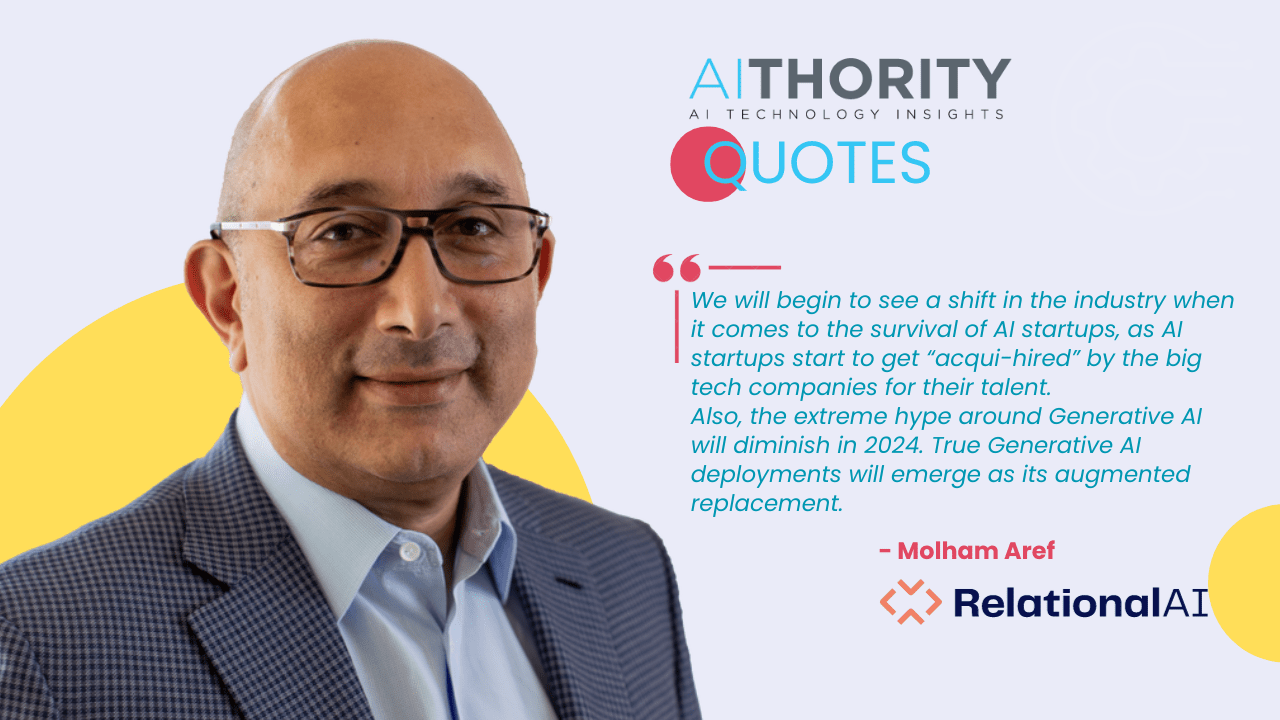AiThority Interview with Molham Aref, Founder and CEO of RelationalAI

Hi, welcome to the AiThority Interview Series. Please tell us a bit about yourself and your company, RelationalAI.
I am the founder and CEO of RelationalAI. I have three decades of AI experience and I often share insights on the rise of the data cloud, knowledge graphs, generative AI and other new-gen technologies. My company brings together decades of experience in industry, technology, and product development to advance the first and only real cloud-native knowledge graph data management system to power the next generation of intelligent data applications.
How do you see the Data Cloud industry shaping in 2024?
In 2024, we will witness the rise of the Data Cloud to advance AI and analytics.
While data clouds are not new, I believe there will be a continued emergence and a clear distinction made between data clouds and compute clouds in 2024. With compute clouds like AWS or Azure, we have had to assemble and stitch together all the components needed to work with AI. So with data clouds, like Snowflake or Microsoft Fabric, users have it all prepackaged together in a single platform, making it much easier to run analytics on data needed to build AI systems. The rise of the data clouds will offer a better starting point for data analytics, Artificial Intelligence (AI), and Machine Learning (ML).
2023 was all about Generative AI and its impact on the Cloud computing platforms. Where is GenAI headed in 2024?
The extreme hype around Generative AI will diminish in 2024. True Generative AI deployments will emerge as its augmented replacement.
In the new year, we will also begin to see the extreme over-hype around generative AI start to diminish. I’ve been working in, and around, AI since the early nineties, AI has always been prone to be over-hyped. Having said that, I think we are going to see enterprises deploying generative AI in more measured and meaningful ways. As with most new technology adoption in the enterprise, it’s going to take longer for these kinds of AI systems to become part of enterprise software in the ERP or HCM sense, but real value will start to be created next year. We will be able to calibrate our expectations appropriately once we begin to see its true impact.
Please tell us about your predictions about AI startups and the VC landscape.
The venture capital climate has been tough as of late and will be even more so in 2024. I believe we will begin to see a shift in the industry when it comes to the survival of AI startups, as AI startups start to get “acqui-hired” by the big tech companies for their talent. This has already started to happen and in the last few months we’ve seen higher than normal venture-funded companies big and small either shut down or quietly get acquired by bigger players.
I think there will be an evolutionary cycle for the companies that can survive the next 18 months or so. It has been said before that some of the best and most valuable companies are usually created in difficult times, like during the 2008 recession and in 2000 when the dot-com bubble burst, as they usually tend to have better products and more disciplined companies. Companies that can run efficiently, be agile, and adapt quickly to tough situations will be better positioned. At the end of the day, companies that have a strong product, and a demonstrated value proposition, will be in a better position to outrun the competition.
How should IT leaders approach Knowledge Graph solutions?
Knowledge Graphs will help users eliminate “Data Silos.”
As enterprises continue to move more data into a data cloud, they are collecting hundreds, thousands, and sometimes even tens of thousands, of data silos in their clouds. Knowledge graphs can easily drive language models to navigate all of the data silos present by leveraging the relationships between various data sources. In the new year, we will see a variety of established and novel AI techniques that support the development of intelligent applications emerge.
Top AIThority.com Cloud News: Top 10 News of AWS in 2023
Thank you, Molham! That was fun and we hope to see you back on AiThority.com soon.
[To share your insights with us, please write to sghosh@martechseries.com]
Molham is the Chief Executive Officer of RelationalAI. He has more than 30 years of experience in leading organizations that develop and implement high-value machine learning and artificial intelligence solutions across various industries. Prior to RelationalAI he was CEO of LogicBlox and Predictix (now Infor), CEO of Optimi (now Ericsson), and co-founder of Brickstream (now FLIR). Molham also held senior leadership positions at HNC Software (now FICO) and Retek (now Oracle).


Comments are closed.